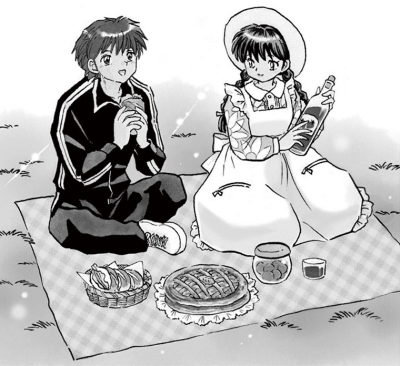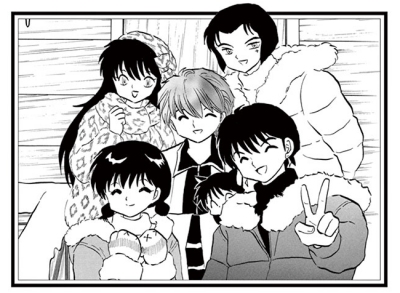

Goodbye, Rinne
By Dylan Acres & Harley Acres

by Dylan Acres
As Kyokai no Rinne comes to an end in its translated form, I find that there is much to look back upon over the course of the series, and my own experience with it. Reading a series on a weely basis over the course of years, it becomes a part of your routine, something to look forward to each week, a touchstone. For me, Kyokai no RINNE began with the end, or death, of a long term relationship, and ended with the death of my father.Death is a major theme that Takahashi covers in Kyokai no RINNE. She has stated in interviews that she never wanted to "laugh at death" and wanted to treat it in a respectful manner that wouldn't be upsetting to readers. [1] At the very end of the English serialization of RINNE, my father passed away. It was a slow process and so it wasn't as shocking as one imagines death can be, but to lose a parent is something that no child of any age can fully prepare themselves for. It would be an overstatement to say that RINNE "taught" me about death, but its certainly true that the series provided respite at times of stress, and reinforced the aspects of death, dying and the grieving process conceptualized by Dr. Elisabeth Kubler-Ross and that I lecture about every semester in my job as a psychology professor.
So much of RINNE is about work and being paid for one's work. Another major transition of my life during its publication was the end of my student days and the beginning of my own professional life. The struggles of paying for things, earning a salary, managing a budget on my own are all things I see reflected in RINNE. But the series doesn't just reflect my own personal working life. The work takes a macro look at the global economy as a whole. When the series first began so many countries were undergoing massive economic upheval from the housing market bubble bursting and the global economy became dangerously unstable. [2]
Additionally, Kyokai no RINNE is a return to comedy for Rumiko Takahashi. So many new fans, especially outside of Japan primarily know Takahashi from Inuyasha, which is a very different series than all her other works. I suspect that many of her fans from Inuyasha didn't follow her over as so many of her previous fans followed her from work to work, Urusei Yatsura and Maison Ikkoku to Ranma 1/2, to Inuyasha. It would be untrue to say that RINNE was a massively popular series. In fact it is Takahashi's lowest selling major work. [3] Of course, sales and popularity are rarely a reflection of quality, and Kyokai no RINNE is as great as anything Takahashi has done previously. The characters are unique and dynamic, new themes drawn from the daily lives and experiences of readers all over the world are featured, and a work that is rooted in the supernatural and afterlife can still feel as human and humane as anything being published. Kyokai no RINNE is definitely a work of its time that will stand the test of time.

by Harley Acres
I can remember when Kyokai no RINNE first began the inevitable comparisons to Tite Kubo's Bleach and Tsugumi Ohba and Takeshi Obata's Death Note were made. Ultimately Kyokai no RINNE proved to be a different animal altogether, one that seemed intent on distancing itself from Takahashi's previous comedies for better or worse. [4] I very much enjoyed Kyokai no RINNE, just as I do every work Takahashi has made, but many English visitors to our site often criticized Sakura as "boring" or "bland", while Rinne's quiet stoicism seemed a radical departure from Takahashi's typically brash and bold protagonists. [5] [6] [7] Rinne and Sakura seemed a good match for one another, quiet and unassuming, but for readers looking for the fireworks of Ataru and Lum, Ranma and Akane or Inuyasha and Kagome the relationship between Kyokai no RINNE's central couple seemed distant and remote.The series was a return to modernity after over a decade of wandering in the feudal era of Inuyasha. One thing I often missed was the variety of locales that Takahashi's modern work brought with it and were inevitably absent in Inuyasha. Cafes, schools, character's homes, vacations, and the changing of the seasons- all of these mainstays of Takahashi's works returned in Kyokai no RINNE, aspects that I sorely missed. The imaginative world of the afterlife proved to be a fruitful exploration that made anything seem possible in Kyokai no RINNE. There was a magic to these mysterious places that felt like a return to the outer space vistas of Urusei Yatsura. The complex bureacracy of the Life Count Administration and Rinne's economic struggles were all highlights as well which brought to mind the best aspects of Terry Gilliam's Brazil.
The commentary of the working poor seemed particularly timely. When Kyokai no RINNE began Japan was entering its third straight decade of post-economic bubble bursting. The Japan have called the 1990s, 2000s, and 2010s their "Lost Decades" due to the economic downturn. The world faced the "global meltdown" and Occupy Wall Street was still fresh on everyone's minds when Kyokai no RINNE debuted. These challenges only seemed to continue as the manga went on and by the time the series ended its run in English translation many millenials were wondering if the dream of home ownership was possible in a world where "side hustles" and part-time work were increasingly the norm.
Kyokai no RINNE was the first series to debut with same-day official translations in English the same day it was released in Shonen Sunday in Japan. [8] This lasted until disruptions caused by the Tohoku Earthquake and tsunami and resulting Fukushima nuclear meltdown ended the simultaneous release. I recall a member of our messageboard that was reading Viz's simultaneous releases stating that the series makes wealthy people seem like the bad guys. [9] She took umbrage at this, stating that her family was wealthy and were not evil. Even at the time this seemed like a tone-deaf assessment of the series (and the general feeling in the world at large when discussions of the 99% vs 1% were taking shape). As the series played out this rich versus poor narrative never took shape. Rinne's poverty was always played for comedy and Takahashi never poked fun at wealth inequality or deeper issues as she typically tries to avoid. Still, the series low-key explorations of poverty felt timely.
Another interesting aspect was Matsugo, a character that comes in the latter half of the series. Matsugo is not Takahashi's first homosexual character (Jakotsu from Inuyasha would have that honor, though one could point to Takahashi's 1984 short story "Happy Talk" and the minor character of Minako as well), but Matsugo is certainly Takahashi's most significant. The lengths Matsugo goes to in order to win Rinne's affection result in some of the funniest stories of the series and his very flamboyant behavior help to show how much the world has changed as homosexuality has become more mainstream. We see this trend continuing with Kagari in MAO.
As Dylan mentioned, Kyokai no RINNE is a series that I read as my life went from that of a student transitioning to moving onto a career track. Translating RINNE chapters each week was at times daunting between grading papers and preparing art history lectures, but the time I had with the characters was always fun. The episodic nature of the series sometimes made for translation challenges when new concepts were often introduced from week to week. Things like "friendly squares" were at times puzzling and left me wondering if I was interpreting Takahashi's translations correctly. Usually by the end of the chapter the punchline would pay off and the joke, obscure initially, would become clear. There was a great sense of learning that comes with processing the original language each week.
The anime for Kyokai no RINNE was an overlooked gem. The animation quality is, in my opinion, perhaps the best and most consistent of any adaptation of Takahashi's work. It is the first series to have true seasons, with breaks that ensured the anime never outpaced the manga. This means the anime was consistently using Takahashi's stories as a basis for each episode and consequently felt very faithful to her work. In many ways the subtle humor and slow-burn jokes of the manga seemed more alive when given voice and movement by the animators. Sakura's deadpan straight-laced act also seemed more interesting when adapted for television.
Ultimately it seems that Kyokai no RINNE will be Takahashi's dark horse, her "lost" series, the under-appreciated gem in her crown of mega-hits. There were no Kyokai no RINNE films, nor video games, only a single soundtrack was released but the series felt like an adventure into the world beyond the land of the living and a welcome return to comedy for Rumiko Takahashi.
Footnotes
- [1] "S Magazine Interview" Quarterly S (季刊 エス), Volume 61. April, 2018, 54-61. https://www.furinkan.com/ takahashi/takahashi22.html.
- [2] Kyokai no RINNE began in April of 2009 towards the end of the "Great Recession" in the United States, which was part of the larger economic slowdown that took place worldwide between 2007 and 2009. At the time Japan was entering its "Lost 30 Years" after the bubble economy of the 1980s burst in the early 1990s.
- [3] "Top Manga." Manga Codex. October 9, 2022. Accessed October 15, 2022. http://www.mangacodex.com/top%20manga.html.
- [4] Yatsura, "I'm pretty sure people will complain about it being 'bleach-ish' But, Bleach didn't even start the shinigami genre...," Rumic World Messageboard, April 22, 2009, https://www.tapatalk.com/groups/ perfectedition/kyokai-no-rinne-manga-discussion-chapter-1-50-t3774-s20.html.
- [5] KawaiiKekeChan, "Out of context, I can see why this makes Sakura seem boring and emotionless," Rumic World Messageboard, May 10, 2012, https://www.tapatalk.com/groups/ perfectedition/kyokai-no-rinne-manga-discussion-chapter-101-200-t4542-s320.html#p66171.
- [6] Yoiko Hibiki, "I sincerely hope that she's developed more in the next 100 chapters, because she's starting to look boring and bland next to the girls that have really big personalities like Ageha and Suzu," Rumic World Messageboard, June 13, 2011, https://www.tapatalk.com/groups/ perfectedition/kyokai-no-rinne-manga-discussion-chapter-101-200-t4542.html#p64041.
- [7] Diko Linnai, "You also have a good point about Sakura being 'perfect,' nado, perfect characters are boring, they have no personal struggles," Rumic World Messageboard, March 20, 2011, https://www.tapatalk.com/groups/ perfectedition/kyokai-no-rinne-manga-discussion-chapter-51-100-t4209-s830.html#p62661.
- [8] Loo, Egan. "Rumiko Takahashi's Rinne to Run in Sync in U.S., Japan." Anime News Network. April 15, 2009. Accessed October 15, 2022. https://www.animenewsnetwork.com/news/2009-04-15/rumiko-takahashi-rinne-to-run-in-sync-in-u.s-japan.
- [9] Diko Linnai, "I don't quite understand though why Takahashi seems to keep demonizing the rich recently with her characters. I'd like to see one character that is wealthy AND a good hearted person. Mendo, Kuno, Mitaka, Misato, possibly Kain, etc.," Rumic World Messageboard, March 18, 2011, https://www.tapatalk.com/groups/ perfectedition/kyokai-no-rinne-manga-discussion-chapter-51-100-t4209-s820.html#p62607.
Over the course of the publication of Kyokai no RINNE Dylan finished graduate school and became a psychology professor while Harley became an art history professor. You can see our video playlist of Kyokai no RINNE videoes. Please visit our Rumic World YouTube Channel for more video essays on other Rumiko Takahashi topics.

Rumic World
|